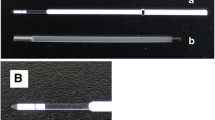Abstract
Purpose
To compare closed-system solid surface vitrification with slow freezing.
Methods
Mouse 2-cell embryos (n = 348) were divided into vitrification, slow freezing and non-frozen groups. For vitrification, embryos were exposed to 10% ethylene glycol (EG), 10% dimethylsulfoxide (DMSO) and 10% fetal bovine serum (FBS) in phosphate-buffered saline (PBS) for 10 min, then transferred into 17.5% EG, 17.5% DMSO, 0.25 M trehalose and 10% FBS in PBS. They were placed on hemi-straws and inserted into 0.5 ml straws inside a previously cooled aluminum cylinder. Slow freezing was done in straws by the conventional method.
Results
Vitrified embryos had significantly higher survival, further cleavage and blastocyst formation rates than those in the slow freezing group (p < 0.001) and were comparable to controls. Blastocysts in the vitrification and control groups had significantly more cells than those in the slow freezing group (p < 0.05).
Conclusions
Closed-system vitrification was more effective than conventional slow freezing.

Similar content being viewed by others
References
Anderson RA. Policy and Practice sub-Group of the British Fertility Society. A strategy for future reproductive services for survivors of cancer. Hum Fertil (Camb). 2003;6:113–5.
Vajta G, Kuwayama M. Improving cryopreservation systems. Theriogenology. 2006;65:236–44.
Martino A, Pollard JW, Leibo SP. Effect of chilling bovine oocytes on their development competence. Mol Reprod Dev. 1996;45:503–12.
Lane M, Bavister BD, Lyons EA, Forest KT. Containerless vitrification of mammalian oocytes and embryos. Nat Biotechnol. 1999;17:1234–6.
Vajta G, Booth PJ, Holm P, Greve T, Callesen H. Successful vitrification of early stage bovine in vitro produced embryos with the open pulled straw (OPS) method. Cryo-Letters. 1997;18:191–5.
Liebermann J, Tucker M, Graham J, Han T, Davis A, Levy MJ. Blastocyst developement after vitrification of multipronucleate zygote using the flexipet denuding pipette (FDP). Reprod Biomed Online. 2002;4:148–52.
Kuwayama M, Vajta G, Ieda S, Kato O. Comparison of open and closed methods for vitrification of human embryos and the elimination of potential contamination. Reprod Biomed Online. 2005;11:608–14.
Angle MJ. Survival and re-expansion of mouse blastocyst following vitrification in two FDA-approved closed devices with and without assisted shrinkage. Fertil Steril. 2007;88(Suppl 1):S90–1.
Bielanski A, Bergeron H, Lau PC, Devenish J. Microbial contamination of embryos and semen during long term banking in liquid nitrogen. Cryobiology. 2003;46:146–52.
Hogan B, Costantini F, Lacy E. Manipulating the mouse embryo: a laboratory manual. New York: Cold Spring Harbor Laboratory; 1986. p. 142–5.
Mukaida T, Wada M, Takahashi K, Pedro PB, An TZ, Kasai M. Vitrification of human embryos based on the assessment of suitable conditions for 8-cell mouse embryos. Hum Reprod. 1998;13:2874–9.
Quinn P, Kerin JF. Experience with the cryopreservation of human embryos using the mouse as a model to establish successful techniques. J In Vitro Fert Embryo Transf. 1986;3:40–5.
Hredzak R, Ostro A, Maracek I, Kacmarik J, Zdilova V, Vesela J. Influence of slow-rate freezing and vitrification on mouse embryos. Acta Veterinaria Brno. 2005;74:23–7.
Ohashi A, Minami N, Imai H. Nuclear accumulation of cyclin B1 in mouse two-cell embryos is controlled by the activation of cdc2. Biol Reprod. 2001;65:1195–200.
Uechi H, Tsutsumi O, Morita Y, Takai Y, Taketani Y. Comparison of the effects of controlled-rate cryopreservation and vitrification on 2-cell mouse embryos and their subsequent development. Hum Reprod. 1999;14:2827–32.
Lee YI, Kwon YS, Park HJ. The experimental study on cryopreservation of mouse embryo. Korean J Fertil Steril. 2001;28:55–64.
Valojerdi MR, Movahedin M, Hosseini A. Improvement of development of vitrified two-cell mouse embryos by vero cell coculture. Assist Reprod Genet. 2002;19:31–8.
Yuan YH, HongMing T, Chong Z, QiongHua H. Study on cryopreservation of 2-cell mouse embryos by straw or OPS vitrification. Chinese J Animal Science. 2004;40:3–6.
Nowshari MA, Brem G. Effect of freezing rate and exposure time to cryoprotectant on the development of mouse pronuclear stage embryos. Hum Reprod. 2001;16:2368–73.
Kuleshova LL, Shaw JM. A strategy for rapid cooling of embryos within a double straw to eliminate the risk of contamination during cryopreservation and storage. Hum Reprod. 2000;15:2604–9.
Kuleshova LL, Lopata A. Vitrification can be more favorable than slow cooling. Fertil Steril. 2002;78:449–54.
Bielanski A. Non-transmission of bacterial and viral microbes to embryos and semen stored in the vapour phase of liquid nitrogen in dry shippers. Cryobiology. 2005;50:206–10.
Begin I, Bhatia B, Baldassarre H, Dinnyes A, Keefer CL. Cryopreservation of goat oocytes and in vivo derived 2- to 4-cell embryos using the cryoloop (CLV) and solid-surface vitrification (SSV) methods. Theriogenology. 2003;59:1839–50.
Sheehan CB, Lane M, Gardner DK. The CryoLoop facilitates re-vitrification of embryos at four successive stages of development without impairing embryo growth. Hum Reprod. 2006;21:2978–84.
Yang QE, Hou YP, Zhou GB, Yang ZQ, Zhu SE. Stepwise in-straw dilution and direct transfer using open pulled straws (OPS) in the mouse: a potential modle for field manipulation of vitrified embryos. J Reprod Dev. 2007;53:211–8.
Cremades N, Sousa M, Silva J, Viana P, Sousa S, Oliveira C, et al. Experimental vitrification of human compacted morulae and early blastocysts using fine diameter plastic micropipettes. Hum Reprod. 2004;19:300–5.
Acknowledgements
This study was supported by a grant from the Faculty of Medicine Endowment Fund for Medical Research, Chiang Mai University, Thailand.
Author information
Authors and Affiliations
Corresponding author
Additional information
Capsule
Closed system solid surface vitrification was more effective than conventional slow freezing in the cryopreservation of mouse 2-cell embryos.
Rights and permissions
About this article
Cite this article
Vutyavanich, T., Sreshthaputra, O., Piromlertamorn, W. et al. Closed-system solid surface vitrification versus slow programmable freezing of mouse 2-cell embryos. J Assist Reprod Genet 26, 285–290 (2009). https://doi.org/10.1007/s10815-009-9324-8
Received:
Accepted:
Published:
Issue Date:
DOI: https://doi.org/10.1007/s10815-009-9324-8




